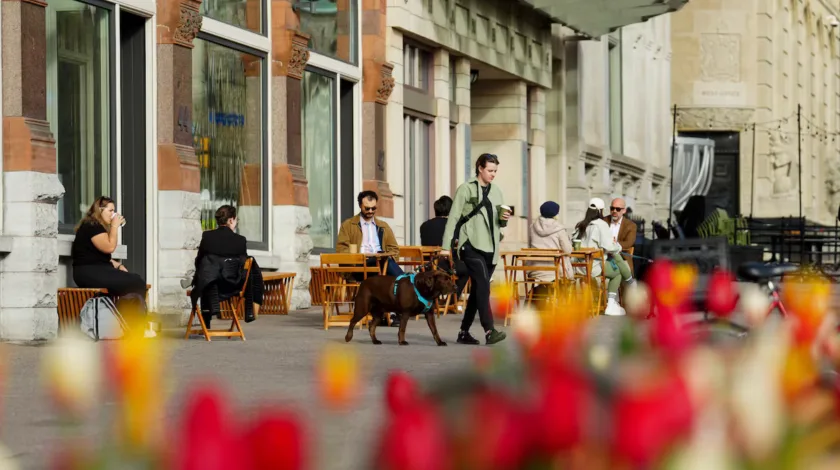Ottawa urged to look beyond returning federal workers to save city’s downtown

Patrons enjoy the outdoor patio as they visit Little Victories coffee shop in downtown Ottawa on May 9. SEAN KILPATRICK/THE CANADIAN PRESS
A major new study on revitalizing Ottawa’s downtown is making the case that bringing federal public servants back to their offices won’t be enough to rejuvenate the core of the nation’s capital, which is grappling with a serious decline in regular visitors.
Rather, the study commissioned by the Ottawa Board of Trade and prepared by the Canadian Urban Institute argues in favour of an effort whose key pieces include adding 40,000 new residents and 50,000 new jobs to the downtown by 2034 through a number of measures.
They include raising $500-million from government and the private sector for a capital investment fund to double down on key projects and enhancing local sites such as the Sparks Street Mall and the Byward Market. There is also a proposal for a program to establish a business incubation district and arts and culture corridor.
The study arrives at a time of growing tension in Ottawa over the government’s changing return-to-work policy, which unions have vowed to fight. Starting in September, public servants will be expected to be in the office for a minimum of three days a week, an increase from two days.
Mary Rowe, the president and CEO of the urban institute, said many downtowns are being reinvented, but Ottawa has a particular challenge because of the dominance of federal services that have overshadowed other uses.
In an interview, she said that while Ontario’s second most populous city is a notable draw for tourists, it needs to have more people living in the core.
“Ottawa used to import tens of thousands of workers who would come in every day to the downtown to work. Now, many of them aren’t and so you replace that with residents.”
To nurture more housing, the report suggests streamlined municipal policies, more density, prioritizing public land for housing, and considering reductions to developer fees. It also calls for an enhanced effort to deal with homelessness, addiction and mental-health challenges affecting the livability of downtown.
Adding 40,000 new residents would yield $120-million annually in new residential property taxes, the report says.
The study, which is titled A Living Capital: Investing in Downtown Ottawa for a Dynamic Future, notes that there are between 25,000 and 40,000 fewer people in downtown Ottawa on any given day than in 2019.
The report notes that downtown occupancy rates are at 43 per cent of pre-COVID occupancy. “Anecdotally, it is clear that on major blocks in Downtown Ottawa, there are commercial spaces with very few workers present on a daily basis – often referred to as ‘zombie buildings,’” it says.
By some estimates, at least 60,000 federal jobs are based in downtown Ottawa. The report noted that, over all, the core provides about 17 per cent of total employment in the city, and about 40 per cent of the city’s office space.
It would be foolish, the authors say, to hope for a return to what was considered normal. “Sentimentality for the past is never an effective strategy when it comes to living things like cites,” says the report, prepared by the urban institute at a cost of $150,000.
The debate over the role of public servants in Ottawa’s fortunes has become more heated in recent weeks.
Both Premier Doug Ford and Ottawa Mayor Mark Sutcliffe have been supportive of more public servants returning to their offices for the benefits they would bring both to the city and its transit system.
However, the unions representing federal workers have balked at the idea of their members being cast as agents of economic recovery. They have promised months of protest and activism aimed at rolling back a federal plan to increase the amount of time workers spend in their offices.
Sueling Ching, the president and CEO of the Ottawa Board of Trade, said in an interview that the city has to kick the habit of leaning on federal workers even though they have been vital to Ottawa’s fortunes.
“Moving forward, our best opportunity to be more resilient is not to say they have to come back and everything will go back to the way it was,” Ms. Ching said in an interview.
She said that without action, the city could become hollowed out in the manner of other North American cities, particularly some in the United States.
Politicians, the National Capital Commission and the Ottawa Senators have been discussing a new sports stadium in central Ottawa at the LeBreton Flats area just west of the city core. The Senators play at the Canadian Tire Centre, which is about 30 kilometres from downtown Ottawa.
However, Ms. Ching said it is not worth banking on the stadium as a positive factor for the city. “It’s not something we can count on,” she said.
“The risk of doing nothing is far too great,” she said. “What the next step will be is to identify who the champions are, who can move this plan forward, and then start looking for ways for us to garner and advocate for the funding that we need to make these investments.”
Source: The Globe and Mail
Author: IAN BAILEY

